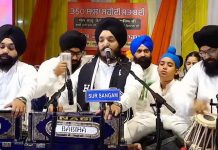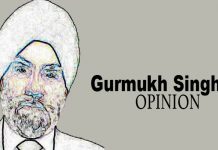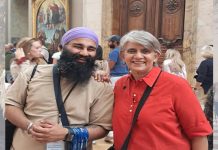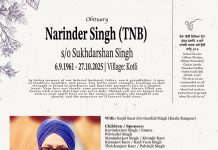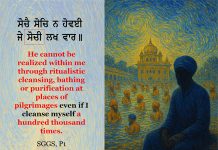
By Gurnam Singh | Opinion |
On 6th December 1704, a battle was fought between the Khalsa, led by Guru Gobind Singh ji, and the coalition forces of the Mughals led by Wazir Khan and the Hindu hill chiefs in the town of Chamkaur Sahib in the Northern Indian State of Punjab. Sikhs across the world are commemorating this important and painful chapter in their history by the usual panoply of Akhand Paths, Nagar Kirtans, and most interestingly open-air kirtan darbars where, in powerful acts of solidarity and remembering of the suffering of the two younger Sahibzada’s, Zorawar Singh and Fateh Singh and their grandmother, Mata Gujar Kaur, the sangat sit outside in freezing cold.
Whilst Sikhs are well practiced in celebrating and commemorating Gurpurabs and festivals, perhaps we are less clear about the importance of remembering key chapters in our amazing history! The English writer George Orwell noted that “The most effective way to destroy people is to deny and obliterate their own understanding of their history.” Similarly, the Black Pan-Africanist Marcus Garvey noted that, “A people without knowledge of their past history, origin and culture is like a tree without roots”. Put another way, to destroy a nation is to erase or corrupt their historical narrative. A good example of this is Prime Minister Narendra Modi declaration almost one year ago that to pay homage to the courage of the “Sahibzades”, or four sons of Guru Gobind Singh ji, the last Sikh Guru in December 26 shall henceforth in India be marked as a “Veer Baal Diwas”
Memorialising war and battles, such as the Battle of Chamkaur, has a particular significance for a nation.
Memory has a strong effect on personal identity and helps to construe and reaffirm collective identities. In war, fighters who are killed on the battlefield are seen by society as “heroes”, or ‘shaheeds’ and their stories may be romanticized or even mythologized. Milan Kundera – Czech novelist, short-story writer, playwright, essayist, and poet, notes: “The first step in liquidating a people is to erase its memory. Destroy its books, its culture, its history. Then have somebody write new books, manufacture a new culture, invent a new history. Before long that nation will begin to forget what it is and what it was… The struggle of man against power is the struggle of memory against forgetting.”
Long after hostilities have concluded, the memories remain and can have a profound impact on the population, including most significantly on women and children at the time of the conflict. And in this regard, the Battle of Chamkaur has special significance for Sikhs. Perhaps because we tend to render women and children as most vulnerable during war, the suffering and the feats of courage displayed by the young sons of Guru Gobind Singh and their Grandmother in resisting the oppression and brutality of the Mogul ruler’s, takes on a wholly different meaning.
One can draw parallels here with the mythological story of the battle between Goliath, who is a character in the Book of Samuel and is described as a giant, and the young boy David. This phrase “David and Goliath” has become quite universal and has taken on a secular meaning, denoting a contest where a smaller, weaker opponent faces a much bigger, powerful adversary, where if successful, the underdog may win in an unusual or surprising way. In some this way, though the Sahibzada’s lost their lives, it was they in their defiance against forced conversion, and not the more powerful Mughal Governor Wazir Khan, who secured the moral victory; and arguably, in dong so, they make a significant dent in the Mogul Empire, which crumbled soon after.
Tragically, Sikh history has been mostly written by the Hindus, Muslims and British, and therefore generally speaking the collective memories of Sikhs have been erased, distorted, misrepresented or appropriated, which is one of the reasons Sikhs are so divided and conflicted in relation to our history. Today, there is a real danger that the Battle of Chamkaur is, too, being appropriated by the Hindutva rulers who prefer to present is as an Indian Nationalist epic. This follows from a rendering of Guru Gobind Singh Sahib as ‘Desh Bhagat’ or Indian Patriot, by Mr Modi during the 350 Birth commemoration in 2017 in his birthplace, Patna Sahib, Bihar. And more recently, during the 400th Birth Anniversary of Guru Tegh Bhadur ji, Mr Modi characterised Guru Sahib as ‘Hind ki Chadar’ or ‘Shield of India’.
There can be no dispute that Guru Sahib responded to a direct plea from the Kashmiri Pandits in their hour of need in the face of an existential threat at the hands of the oppressive Mogul Emperor Aurangzeb and his policy of forced conversion to Islam. Whilst Guru Sahib’s sentiments may well have been with the Kashmiri Pandits, according to his own writings contained in Guru Granth Sahib ji, his motivation to confront Aurangzeb was based on a much wider belief in the universal right to freedom of belief. For example, in Salok Mahala 9, (GGS, 1427) Guru Sahib proclaims, “One who does not give threats, and who resists threats from others. Nanak says, listen, O mind, he alone is wise and knowledgable.”
In this regard, Guru Tegh Bhadur Ji is more accurately characterised not as the protector of the ‘Hindu faith’, but, as noted by the Poet Senapati in his Sri Gur Sobha, Guru Sahib ‘Sriti di Chadar’ or ‘The Shield of the whole of creation.’ Similarly, in Sri Gur Panth Prakash, Sikh historian Rattan Singh Bangoo, notes that Guru Sahib ‘gave his life for the protection of other’s human rights’.
Some may argue that making such distinctions about differing versions of history is splitting hairs and that questioning the motives of the rulers is not wise. There is no doubt that this perspective is prevalent amongst some Sikhs. For example, the so-called ‘Sant Smajh’ or ‘Society of Saints’, along with prominent political figures, such as former President of the Delhi Sikh Gurdwara Management Committee (DSGMC), Manjinder Singh Sirsa, have heaped praise on Narendra Modi and the BJP for their commitment to Sikhs. However, this begs the question, by providing legitimation for the violent Hindutva project, and by rendering the sacrifice of the 4 Sahibzadas, and indeed, the whole family of Guru Gobind Singh, in the cause of Hindu Nationalism, in what way are you honouring their supreme sacrifice!
Can you imagine Muslims or Christians, or Hindus, or Jews, or Europeans, or Americans or anybody allowing others to narrate their histories? Well, tragically this appears to be the norm for Sikhs, but still it is not too late. So the moral is, yes, let’s commemorate our history, let’s not forget the supremes sacrifices of our countless Shaheeds, but it must be told on our terms. And that means Sikhs producing an official history rather than relying others to tell us who and what we are!

Gurnam Singh is an academic activist dedicated to human rights, liberty, equality, social and environmental justice. He is an Associate Professor of Sociology at University of Warwick, UK. He can be contacted at Gurnam.singh.1@warwick.ac.uk
* This is the opinion of the writer and does not necessarily represent the views of Asia Samachar.
RELATED STORY:
When we go overboard with the Baba Deep Singh story (Asia Samachar, 16 Nov 2022)
ASIA SAMACHAR is an online newspaper for Sikhs / Punjabis in Southeast Asia and beyond.Facebook | WhatsApp +6017-335-1399 | Email: editor@asiasamachar.com | Twitter | Instagram | Obituary announcements, click here |








